DNA Sequencing Market Size and Share
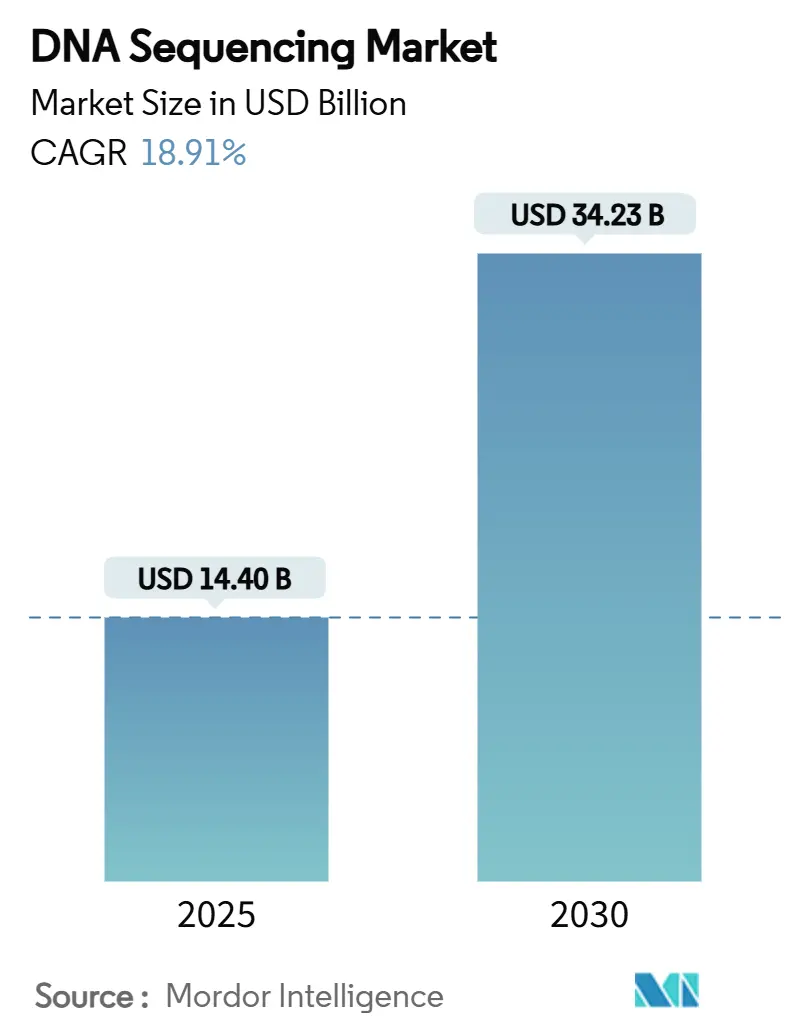
DNA Sequencing Market Analysis by Mordor Intelligence
The DNA sequencing market size reached USD 14.40 billion in 2025 and is projected to touch USD 34.23 billion by 2030, reflecting an 18.91% CAGR over the forecast window. Demand is shifting from academic discovery toward routine clinical testing in oncology, rare disease, and infectious-disease surveillance. A sustained drop in cost-per-genome, steady reimbursement expansion, and government-funded precision-medicine programs are widening patient access while enlarging installed instrument bases. Nanopore and other long-read platforms are eroding the short-read stronghold by resolving complex genomic regions, whereas cloud bioinformatics and AI pipelines streamline interpretation and cut turnaround times. Nevertheless, fragmented data-privacy rules and geopolitical supply-chain risks raise compliance costs and threaten reagent continuity, tempering growth momentum.
Key Report Takeaways
- By product & service, consumables held 58.11% of DNA sequencing market share in 2024 while sequencing-as-a-service is expected to scale at an 18.21% CAGR through 2030.
- By sequencing technology, next-generation sequencing accounted for 81.51% of the DNA sequencing market share in 2024; nanopore sequencing is forecast to post a 28.41% CAGR between 2025 and 2030.
- By workflow step, sequencing activities captured 45.31% of the DNA sequencing market size in 2024, whereas data analysis and storage are projected to climb at a 20.11% CAGR to 2030.
- By application, clinical diagnostics represented 50.71% of revenue in 2024 and oncology diagnostics is rising at a 19.31% CAGR over 2025-2030.
- By end user, academic institutions controlled 40.21% of the DNA sequencing market size in 2024 while hospitals and clinical laboratories are anticipated to grow at a 17.11% CAGR through 2030.
- By geography, Asia Pacific is the fastest-growing region with a 19.63% CAGR, whereas North America retained a 45.11% revenue share in 2024.
Global DNA Sequencing Market Trends and Insights
Driver Impact Analysis
| Driver | % Impact on CAGR Forecast | Geographic Relevance | Impact Timeline |
|---|---|---|---|
| Declining cost-per-genome with higher-throughput platforms | +2.0% | Global | Long term (≥ 4 years) |
| Broader reimbursement and approvals for clinical sequencing | +1.7% | North America, Europe, Asia Pacific | Medium term (2-4 years) |
| Government precision-medicine and population genomics programs | +1.5% | US, EU, Asia Pacific | Long term (≥ 4 years) |
| Genomics-based drug discovery and companion diagnostics uptake | +1.3% | Global | Medium term (2-4 years) |
| Expansion of long-read, single-cell and multi-omics workflows | +1.2% | Global | Long term (≥ 4 years) |
| Growth of sequencing-as-a-service and cloud bioinformatics | +1.0% | Global (strongest in developed hubs) | Short term (≤ 2 years) |
| Source: Mordor Intelligence | |||
Declining Cost-Per-Genome Revolutionizes Access
Sequencing a whole human genome has fallen from USD 1 million in 2007 to under USD 600 in 2025, unlocking routine use across community hospitals. Illumina’s NovaSeq X cuts that figure below USD 200, and Ultima Genomics markets a USD 100 genome, altering budget allocation toward data interpretation tools. United Kingdom oncology centers now deploy whole-genome sequencing for pediatric cancers, and Germany and Sweden are piloting similar programs[1]National Health Service, “Genomic Medicine Service Update 2024,” nhs.uk. Vendors are pivoting from hardware sales to application-specific solutions; Illumina’s acquisition of Fluent BioSciences strengthens single-cell assay portfolios, underscoring a shift toward higher-margin, software-rich offerings. As costs approach commodity levels, competitive focus centers on differentiated chemistry and bioinformatics ecosystems.
Broader Reimbursement Accelerates Clinical Adoption
Centers for Medicare & Medicaid Services expanded national coverage for next-generation sequencing in solid tumors in 2024, removing a primary barrier to uptake. The National Comprehensive Cancer Network now recommends whole-genome sequencing for acute myeloid leukemia, further cementing clinical demand. Yet reimbursement remains patchy across private payers and European insurers, prompting vendors to invest in health-economics evidence packages and payer-education teams. Local Coverage Determinations increasingly target high-value uses such as indeterminate pulmonary-nodule risk stratification, creating incremental tailwinds.
Government Precision-Medicine Programs Drive Infrastructure
The US National Human Genome Research Institute directs USD 5.3 million annually toward embedding genomics in routine care, while Singapore’s National Precision Medicine initiative partners with PacBio and Oxford Nanopore to generate long-read reference genomes for Asian populations. European Horizon projects dedicate grant funding to polygenic-risk-score development for under-represented ancestries. Such programs provide sequencer placements, biobank samples, and standard operating procedures that collectively lower commercial-entry barriers and expand the DNA sequencing market.
Genomics-Based Drug Discovery Expands Applications
Pharmaceutical developers rely increasingly on large-scale sequencing for target validation and companion diagnostics. Illumina is piloting a whole-genome minimal residual-disease test for solid tumors, enabling early relapse detection. Artificial-intelligence platforms trained on multi-omics datasets accelerate hit-to-lead cycles, with the AI in bioinformatics segment predicted to surpass USD 37 billion by 2029[2]US Food and Drug Administration, “Artificial Intelligence in Drug Development Framework,” fda.gov. The FDA guidance on decentralized clinical trials allows remote genomic sample collection, broadening patient participation and cementing sequencing as a backbone of future drug development.
Restraints Impact Analysis
| Restraints Impact Analysis | (~) % Impact on CAGR Forecast | Geographic Relevance | Impact Timeline |
|---|---|---|---|
| High capital and operating costs of high-throughput systems | −1.6% | Global | Short term (≤ 2 years) |
| Bioinformatics talent shortage and analysis bottlenecks | −1.4% | Global (acute in emerging markets) | Medium term (2-4 years) |
| Fragmented global regulatory and data-privacy landscape | −1.3% | North America, EU, cross-border trade | Medium term (2-4 years) |
| Supply-chain volatility for critical reagents and flow cells | −1.1% | Global (notably US–China corridors) | Short term (≤ 2 years) |
| Source: Mordor Intelligence | |||
High Capital Costs Create Market Entry Barriers
A top-tier high-throughput instrument can exceed USD 1 million, with annual maintenance contracts adding significant overhead. Smaller laboratories defer acquisition or rely on reagent-rental models and centralized core facilities. Element Biosciences attempts to democratize access with the USD 289,000 AVITI system that features per-gigabase operating costs of USD 2-USD 5, yet the razor-and-blade economics still favor incumbents that control consumable supply. Capital requirements therefore slow expansion in low-resource settings and reinforce economies of scale for established vendors.
Bioinformatics Bottlenecks Constrain Value Extraction
Sequencer throughput keeps doubling, while demand for data-science professionals has jumped 42% since 2018. Shortages in Python, SQL, and R expertise delay variant interpretation, limiting clinical utility. Automation efforts such as Illumina’s DRAGEN pipeline and DNAnexus-Intelliseq’s AI-driven annotation alleviate but do not eliminate these gaps. Complex structural-variant calling and novel rare-variant curation still need manual review, constraining the speed at which end users can translate sequencing data into actionable decisions.
Segment Analysis
By Product & Service: Recurring Consumables Revenue Dominates Operating Models
Consumables generated 58.11% of revenue in 2024 owing to proprietary flowcells and reagent kits that users must reorder for every run, underscoring the razor-and-blade model that supports the DNA sequencing market. Margins on chemistry routinely outpace those on instruments, funding accelerated product refresh cycles. Services, including sequencing-as-a-service and data analytics, are climbing at an 18.21% CAGR as laboratories outsource complex informatics and compliance workloads.
Consumable innovation now focuses on lowering cost and increasing throughput. Ultima Genomics is moving to unpatterned wafers that shrink lithography expense and facilitate scale-out manufacturing. Meanwhile, service providers such as DNAnexus couple cloud compute, compliance, and AI interpretation to deliver end-to-end actionable reports rather than raw data, enhancing customer stickiness. Together these shifts position recurring consumables and managed services as the lifeblood of the DNA sequencing market.
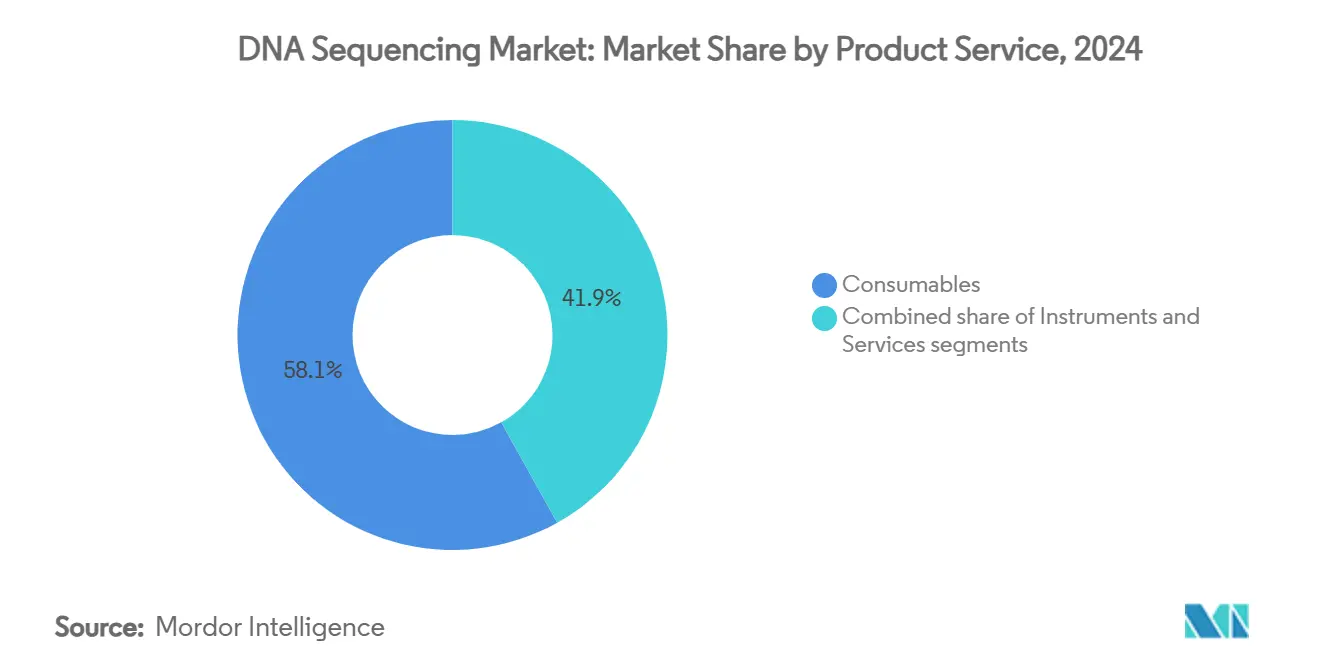
Note: Segment shares of all individual segments available upon report purchase
By Sequencing Technology: Short-Read Platforms Still Dominate but Long-Read Solutions Close the Gap
Next-generation short-read instruments captured 81.51% of revenue in 2024 thanks to validated clinical workflows, high accuracy, and wide assay menus. Nanopore sequencing is the fastest-growing subsegment at a 28.41% CAGR, propelled by real-time long reads that resolve structural variants and methylation patterns. PacBio’s SPRQ chemistry drops HiFi human genome costs below USD 500, improving affordability for population studies.
Oxford Nanopore’s PromethION 2 Integrated delivers up to 290 Gb per flowcell with onboard compute, while its 99.7% single-nucleotide accuracy strengthens clinical credibility. Vendors increasingly promote hybrid pipelines that merge short-read economy with long-read context, broadening use scenarios from oncology to metagenomics and transcriptomics. Competitive intensity is therefore accelerating innovation pace across both read-length regimes.
By Workflow Step: Data Analysis Becomes Principal Growth Engine
Sequencing itself retained 45.31% of 2024 revenue, yet data analysis and storage are expected to grow 20.11% annually through 2030. Growth reflects escalating file sizes from multi-omics projects and the clinical need for rapid, confident interpretation. Illumina’s DRAGEN 4.3 introduces multi-genome graph mapping, while tools such as Sniffles2 refine structural-variant calling in long-read files.
Laboratory automation extends upstream to sample prep, with low-input, multichannel library kits trimming hands-on minutes and reagent waste. Cloud pipelines democratize high-performance computation, letting mid-tier hospitals bypass local server investment. As reimbursement ties payment to actionable reports rather than raw sequence, value migrates to informatics, solidifying analysis as the fastest-growing revenue layer in the DNA sequencing market.
By Application: Diagnostics Surpass Research As Chief Revenue Contributor
Clinical diagnostics produced 50.71% of sales in 2024, overtaking research uses for the first time. Oncology drives uptake, with comprehensive genomic profiling gaining payer endorsement through 2030. ASCO emphasizes RNA sequencing to capture fusions that DNA assays may miss, broadening the clinical toolkit[3]American Society of Clinical Oncology, “Molecular Testing Guideline 2024,” asco.org.
Rare disease, pharmacogenomics, and reproductive health applications also expand. A Romanian lung-cancer cohort saw actionable variants in 74.8% of patients via upfront NGS, though only 35.3% accessed matched therapy because of reimbursement and performance-status barriers. Molecular residual-disease tests aim to provide longitudinal cancer monitoring, setting the stage for recurring patient testing and sustained revenue for the DNA sequencing market.
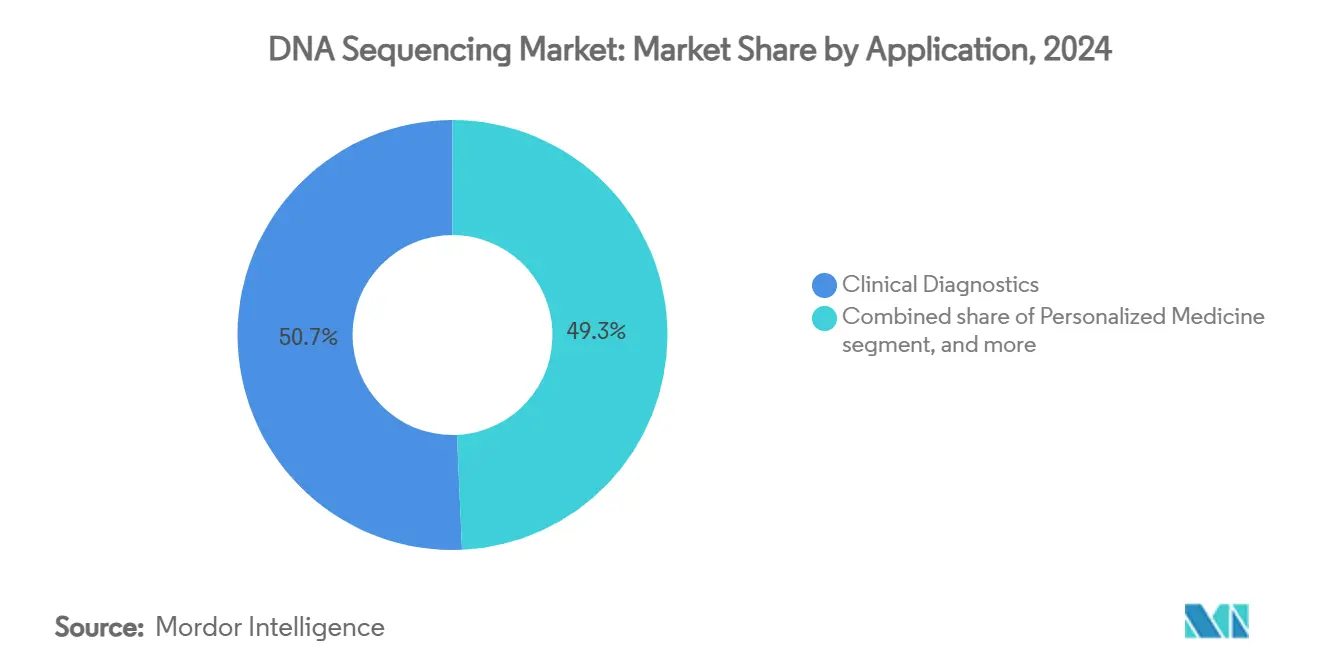
Note: Segment shares of all individual segments available upon report purchase
By End User: Academic Centers Pioneer, Hospitals Scale Adoption
Academic institutions commanded 40.21% of 2024 revenue, leveraging grant funds to pilot single-cell and spatial-omics workflows. Hospitals and clinical labs are projected to grow 17.11% per year through 2030 as turnkey platforms simplify validation and reporting. Illumina’s MiSeq i100 offers four-hour runs and ambient-temperature reagents, enabling same-day pathogen detection in urgent-care settings.
Pharmaceutical and biotechnology companies integrate sequencing into target discovery, patient stratification, and companion-diagnostic co-development, providing a steady pipeline of contract sequencing work. Niche users in forensic genetics and consumer wellness add incremental volume, though they raise privacy and ethical considerations that require robust governance frameworks.
Geography Analysis
North America accounted for 45.11% of 2024 revenue, fueled by Medicare coverage expansion, abundant venture capital, and a supportive FDA framework. The National Institutes of Health channel multi-year grants into rare-disease and cancer-genome initiatives, while infrastructure laws incentivize bio-manufacturing. Proposed US legislation restricting Chinese genomic suppliers, however, threatens reagent flow and increases inventory costs for domestic labs.
Asia Pacific is poised to be the fastest-growing territory with a 19.63% CAGR, driven by population-scale sequencing projects and rising healthcare spend. China dominates volume through hospital cancer registries and direct-to-consumer tests, whereas Singapore’s long-read population program aims to create a high-quality Asian reference genome that underpins regional assays. India announces biobank networks under its National Genomics Mission, though disparate reimbursement hinders clinical roll-out.
Europe maintains significant share through publicly funded health systems that embed genomic testing into routine care. The General Data Protection Regulation enforces strict consent protocols and cross-border data rules, raising compliance costs. The UK’s Genomics England targets 5 million whole genomes, Germany funds hospital digitalization for genomic data integration, and France’s national plan scales newborn-screening pilots. Emerging markets in the Middle East, Africa, and South America remain nascent but invest in oncology sequencing and infectious-disease surveillance as costs fall and mobile labs spread to remote clinics.
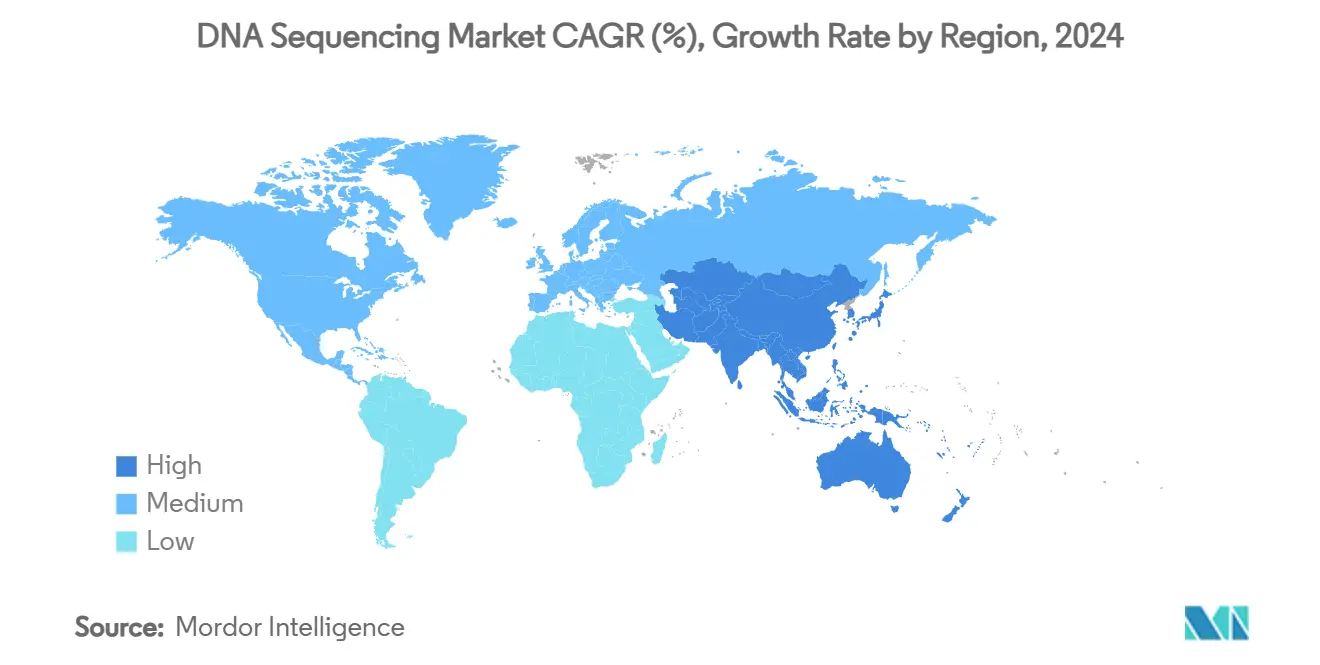
Competitive Landscape
The DNA sequencing market is moderately concentrated. Illumina retains close to 66% of global placements through its MiSeq, NextSeq, and NovaSeq families. Oxford Nanopore and PacBio compete in long-read niches, while Element Biosciences challenges benchtop economics with the AVITI system’s USD 2-USD 5 per-gigabase running cost.
Strategic acquisitions shape competition. Illumina bought Fluent BioSciences for single-cell assay capabilities, and Hitachi High-Tech acquired Nabsys to commercialize electronic genome mapping. PacBio’s SPRQ chemistry narrows cost gaps, and newcomers such as 454.bio aim to deliver open-source sequencers at roughly USD 33 per run, targeting educational markets.
Supply-chain resilience has emerged as a competitive differentiator amid proposed US restrictions on Chinese genomics vendors. Vendors are diversifying reagent manufacturing footprints and forging second-source agreements. White-space opportunities persist in point-of-care sequencing, fully automated sample-to-report instruments, and integrated analysis platforms that ease the bioinformatics bottleneck.
DNA Sequencing Industry Leaders
-
Merck KGaA
-
Thermo Fisher Scientific, Inc.
-
Agilent Technologies, Inc.
-
Illumina, Inc.
-
F. Hoffmann-La Roche Ltd.
- *Disclaimer: Major Players sorted in no particular order
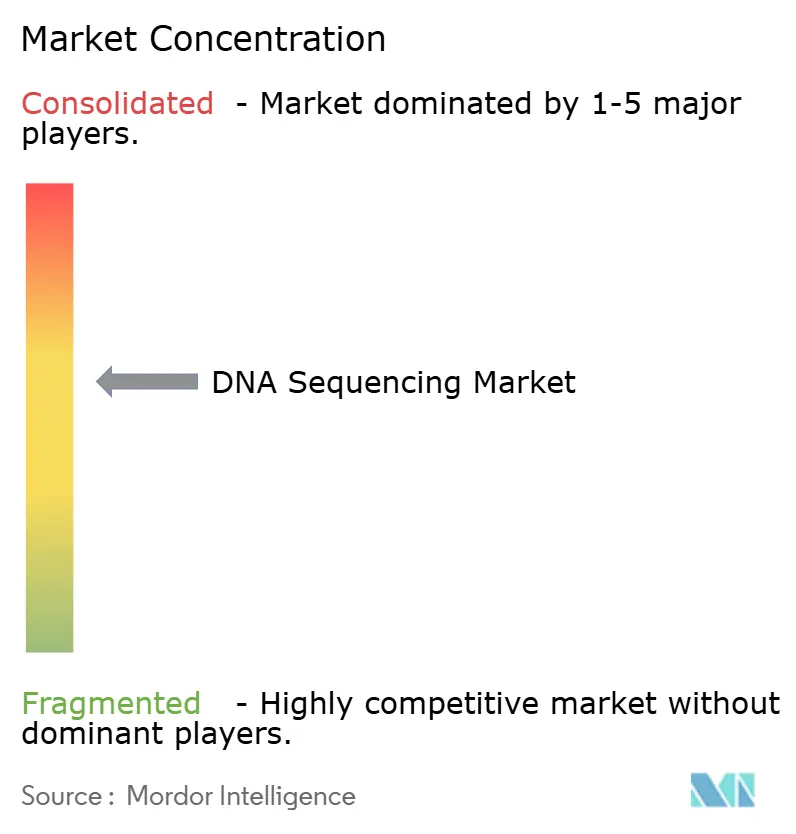
Recent Industry Developments
- January 2025: Illumina invested USD 320 million in Truveta, strengthening access to real-world clinical data analytics.
- January 2025: MaxCyte acquired SeQure Dx to bolster cell- and gene-therapy editing assessments.
- October 2024: Element Biosciences released Trinity, a targeted-sequencing workflow that trims exome-capture time and cost.
- October 2024: Illumina launched MiSeq i100 Series with room-temperature cartridges and four-hour runs.
- October 2024: PacBio introduced SPRQ chemistry for Revio, lowering HiFi human-genome cost below USD 500.
Global DNA Sequencing Market Report Scope
As per the scope of the report, DNA sequencing is the procedure of determining or identifying the sequence of nucleotides within a DNA molecule. This information is useful for researchers in understanding the type of genetic information that is carried in the DNA, which may affect its function in the body. It can then, in turn, help to detect genetic changes that may be associated with causing certain health conditions. The DNA Sequencing Market is Segmented by Product Type (Instruments, Consumables, and Other Product Types), Sequencing Type (Sanger Sequencing, Next-generation Sequencing, and Other Sequencing Types), Application (Diagnostics, Personalized Medicine, and Other Applications), End User (Hospitals and Healthcare Organizations, Academics and Research Institutions, Pharmaceutical and Biotechnology Companies, and Other End Users), and Geography (North America, Europe, Asia-Pacific, Middle East and Africa, and South America). The report also studies the biopharmaceuticals market in 17 different countries across major regions across the world. The report offers the value (in USD million) for the above segments.
| Instruments |
| Consumables |
| Services |
| Sanger Sequencing | |
| Next-Generation Sequencing (NGS) | Illumina SBS |
| Ion Semiconductor | |
| Other Technologies | |
| Third-Generation Sequencing |
| Sample Preparation |
| Library Preparation |
| Sequencing |
| Data Analysis & Storage |
| Clinical Diagnostics | Oncology |
| Reproductive Health (NIPT, Carrier) | |
| Infectious Disease | |
| Rare & Genetic Disorders | |
| Personalized Medicine | |
| Drug Discovery & Development | |
| Other Applications |
| Hospitals & Clinical Laboratories |
| Academic & Research Institutes |
| Pharmaceutical & Biotechnology Companies |
| Other End Users |
| North America | United States |
| Canada | |
| Mexico | |
| Europe | Germany |
| United Kingdom | |
| France | |
| Italy | |
| Spain | |
| Rest of Europe | |
| Asia-Pacific | China |
| Japan | |
| India | |
| Australia | |
| South Korea | |
| Rest of Asia-Pacific | |
| Middle East & Africa | GCC |
| South Africa | |
| Rest of Middle East & Africa | |
| South America | Brazil |
| Argentina | |
| Rest of South America |
| By Product & Service | Instruments | |
| Consumables | ||
| Services | ||
| By Sequencing Technology | Sanger Sequencing | |
| Next-Generation Sequencing (NGS) | Illumina SBS | |
| Ion Semiconductor | ||
| Other Technologies | ||
| Third-Generation Sequencing | ||
| By Workflow Step | Sample Preparation | |
| Library Preparation | ||
| Sequencing | ||
| Data Analysis & Storage | ||
| By Application | Clinical Diagnostics | Oncology |
| Reproductive Health (NIPT, Carrier) | ||
| Infectious Disease | ||
| Rare & Genetic Disorders | ||
| Personalized Medicine | ||
| Drug Discovery & Development | ||
| Other Applications | ||
| By End User | Hospitals & Clinical Laboratories | |
| Academic & Research Institutes | ||
| Pharmaceutical & Biotechnology Companies | ||
| Other End Users | ||
| Geography | North America | United States |
| Canada | ||
| Mexico | ||
| Europe | Germany | |
| United Kingdom | ||
| France | ||
| Italy | ||
| Spain | ||
| Rest of Europe | ||
| Asia-Pacific | China | |
| Japan | ||
| India | ||
| Australia | ||
| South Korea | ||
| Rest of Asia-Pacific | ||
| Middle East & Africa | GCC | |
| South Africa | ||
| Rest of Middle East & Africa | ||
| South America | Brazil | |
| Argentina | ||
| Rest of South America | ||
Key Questions Answered in the Report
What is the projected value of the DNA sequencing market by 2030?
The DNA sequencing market is expected to reach USD 34.23 billion by 2030, reflecting sustained double-digit growth.
Which technology segment is expanding fastest?
Nanopore sequencing is forecast to grow at a 28.41% CAGR as its long-read capability gains traction in structural-variant and epigenetic analysis.
How significant are consumables in vendor revenue models?
Consumables represented 58.11% of 2024 revenue, illustrating the importance of proprietary reagents and flowcells in sustaining cash flow.
Why is Asia Pacific viewed as a key growth engine?
Population-scale precision-medicine initiatives and rising healthcare investment are driving a 19.63% CAGR for Asia Pacific through 2030.
What main barriers limit wider sequencing adoption?
High instrument capital costs and a shortage of skilled bioinformatics professionals restrain broader uptake despite falling per-genome prices.
How dominant is Illumina in today’s competitive landscape?
Illumina controls roughly 66.11% of global system installations but faces growing competition from PacBio, Oxford Nanopore, and Element Biosciences.
Page last updated on:



